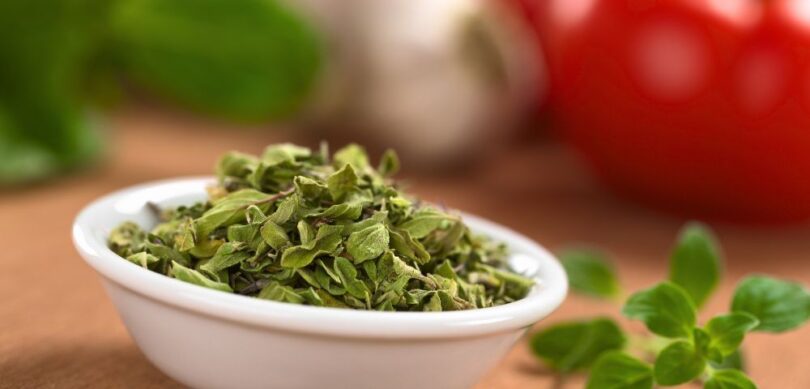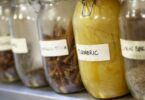I often receive questions about dried oregano.
Here’s a post that should answer most of the questions I’ve received, from harvesting oregano to drying and using this magnificent herb.
Below is a list of all the topics I will cover in this guide. Go ahead and click on any of these links, and you’ll be taken to that specific section.
- How to harvest oregano
- When to harvest oregano for drying
- Can you harvest oregano after it flowers
- How to dry oregano
- Storing dried oregano
- Dried oregano uses, benefits, and nutrition
- Dried oregano benefits
- Fresh vs dried oregano
- Dried oregano nutrition facts
- Fresh oregano nutrition facts
Drying Oregano – from Harvesting to Storing It
How to harvest oregano
Before you start drying oregano, you obviously have to harvest it, and even better, harvest it sustainably.
Follow these steps:
- Wait until the oregano plant has plenty of leaves. I usually wait until the plant is at least 6 inches tall.
- Use scissors or a sharp knife to cut off sprigs of oregano. Make sure to leave enough leaves on the plant so it can continue to grow.
- Rinse the oregano sprigs under cold water to remove any dirt or debris.
- Pat the sprigs dry with a paper towel or let them air dry.
SEE ALSO: How to Harvest Oregano – A Complete Guide
When to harvest oregano for drying
I usually harvest oregano for drying just before the plant flowers, and the leaves have the most flavor and aroma. This is usually in the late spring or early summer.
Can you harvest oregano after it flowers
Yes, you can harvest oregano after it flowers. The plant will continue to produce new leaves even after it has flowered, so you can continue to harvest oregano throughout the growing season.
The flavor and aroma of oregano may be slightly diminished after the plant has flowered. If you want the strongest flavor and aroma, harvest oregano just before the plant flowers.
How to dry oregano
There are different methods for drying oregano. As I have a dehydrator, this is also my preferred method. But there are other methods you can use to dry oregano without a dehydrator.
Drying oregano with a dehydrator
- Spread the oregano out on the dehydrator trays and set the dehydrator to a low temperature.
- It will usually take around 4 hours, depending on the number of leaves to dry and the humidity.
How to dry oregano without a dehydrator?
- Drying oregano in an oven: Preheat the oven to the lowest setting and spread the oregano out on a baking sheet. Place the sheet in the oven and leave the oven door slightly open to give the herbs good air circulation. Bake the oregano for 30min to 45min, turn the oven off, and leave the oregano in the oven for another 30 min, or until the leaves are crispy and dry.
- Hang-drying oregano: Tie the oregano sprigs together with string and hang them upside down in a cool, dry place with good air circulation. This method can take several days to a week to dry the oregano completely.
SEE ALSO: 4 Methods of Drying Oregano at Home
Storing dried oregano
Follow these steps:
- Once the oregano is fully dry, remove the leaves from the stems and discard the stems.
- Use an airtight container, such as a jar with a tight-fitting lid or a plastic bag with the air squeezed out.
- Store the container in a cool, dry place, away from direct sunlight and heat.
Although dried oregano can be stored for several months, the flavor and aroma may decrease with time. You can keep dried oregano in the refrigerator or freezer to increase its shelf life.
Dried Oregano Uses, Benefits, and Nutrition
Here are some ways I use dried oregano in my cooking:
- Sprinkling dried oregano over roasted vegetables, such as zucchini, tomatoes, and bell peppers.
- Adding a pinch of dried oregano to sauces, soups, and stews for added flavor.
- Mix dried oregano with olive oil and use it as a marinade for grilled chicken or lamb.
- Sprinkling dried oregano over pizzas, sandwiches, and other dishes that could benefit from a boost of flavor.
- Adding dried oregano to dry rubs for grilling or roasting meat, poultry, or fish.
- Using dried oregano as a seasoning for homemade dips and spreads, such as hummus or baba ghanoush.
- Mix dried oregano with other herbs, such as basil, thyme, and rosemary, to create a flavorful blend for seasoning dishes.
Remember that dried oregano has a strong, aromatic flavor, so use it with care. Enjoy!
Dried oregano benefits
Dried oregano is a popular herb that is used in many dishes for its bold, aromatic flavor. In addition to its culinary uses, oregano has a number of potential health benefits.
Here are some of the benefits of dried oregano:
Antioxidant properties
Oregano is a good source of antioxidants, which are compounds that help protect cells from damage caused by free radicals. Some studies have suggested that oregano may have potent antioxidant properties, which may help protect against certain diseases.
Anti-inflammatory properties
Some research has suggested that oregano may have anti-inflammatory properties, which may help reduce inflammation in the body. Inflammation is a natural response to injury or infection, but chronic inflammation has been linked to a number of diseases, including heart disease, diabetes, and cancer.
Antimicrobial properties
Oregano has been traditionally used as a natural remedy for various ailments, including respiratory infections and digestive problems. Some research has suggested that oregano may have antimicrobial properties, which may help inhibit the growth of bacteria, viruses, and other microorganisms.
SEE ALSO: 7 Amazing Health Benefits of Oregano
Fresh vs Dried Oregano
Fresh oregano and dried oregano are both popular herbs. However, there are some differences between the two:
- Fresh oregano has a stronger, more pungent flavor than dried oregano. This is because the drying process can cause the flavor and aroma of the oregano to fade. Dried oregano has a more concentrated flavor than fresh oregano, so you’ll need to use less of it in your recipes.
- Fresh oregano has a softer, more delicate texture than dried oregano. Dried oregano is more brittle and crumbly, due to the drying process.
- Fresh oregano has a shorter shelf life than dried oregano. It will last for a few days in the refrigerator or up to a week in a cool, dark place. Dried oregano, on the other hand, can be stored for several months in an airtight container in a cool, dry place.
- Both fresh and dried oregano can be used in a variety of dishes, including sauces, marinades, soups, stews, and roasted vegetables. However, fresh oregano may be better suited for dishes that are served raw or that don’t require long cooking times, as the flavor and aroma may fade during prolonged cooking. Dried oregano, on the other hand, is often used in dishes that require longer cooking times, as the concentrated flavor can hold up well in the heat.
In general, both fresh and dried oregano can be used interchangeably in recipes, although you may need to adjust the amount you use depending on the form of the oregano and the strength of the flavor you desire.
Dried oregano nutrition facts
Dried oregano is a good source of nutrients, including vitamins, minerals, and antioxidants.
Here are the nutrition facts for a 1-tablespoon (2.8-gram) serving of dried oregano:
- Calories: 5
- Protein: 0.6 grams
- Fat: 0.3 grams
- Carbohydrates: 0.9 grams
- Fiber: 0.5 grams
- Vitamin K: 48% of the daily value (DV)
- Iron: 12% of the DV
- Manganese: 10% of the DV
- Calcium: 8% of the DV
- Vitamin E: 6% of the DV
- Vitamin C: 5% of the DV
Keep in mind that these nutrition facts are for a small serving of dried oregano, and the number of nutrients you’ll get from the herb will depend on the amount you use in your recipes. Dried oregano is also a good source of antioxidants, which are compounds that help protect cells from damage caused by free radicals.
Fresh oregano nutrition facts
Fresh oregano is a good source of nutrients, including vitamins, minerals, and antioxidants. Here are the nutrition facts for a 1-cup (22-gram) serving of fresh oregano:
- Calories: 6
- Protein: 0.6 grams
- Fat: 0.3 grams
- Carbohydrates: 1.3 grams
- Fiber: 0.7 grams
- Vitamin K: 122% of the daily value (DV)
- Iron: 11% of the DV
- Manganese: 10% of the DV
- Calcium: 9% of the DV
- Vitamin E: 6% of the DV
- Vitamin C: 5% of the DV
Keep in mind that these nutrition facts are for a small serving of fresh oregano, and the number of nutrients you’ll get from the herb will depend on the amount you use in your recipes. Fresh oregano is also a good source of antioxidants, which are compounds that help protect cells from damage caused by free radicals.





